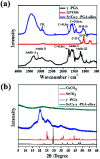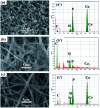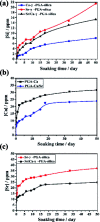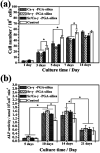Fabrication of strontium/calcium containing poly(γ-glutamic acid) - organosiloxane fibrous hybrid materials for osteoporotic bone regeneration
- PMID: 35539801
- PMCID: PMC9082659
- DOI: 10.1039/c8ra03957g
Fabrication of strontium/calcium containing poly(γ-glutamic acid) - organosiloxane fibrous hybrid materials for osteoporotic bone regeneration
Abstract
Recent researches have proved that combination of several therapeutic metal ions, such as silicate (Si), calcium (Ca), strontium (Sr) and so on, with biomaterials may have promising effects for stimulating bone regeneration. In the present study, the Sr/Ca containing silicate hybrid materials (Sr/Ca-γ-PGA-silica) with a mimetic native extracellular matrix (ECM) structure have been developed by electrospinning. With the aim to promote the solubility of γ-PGA in aqueous-based solution and introduce Sr/Ca elements into the prepared hybrid materials, SrCO3 and CaCO3 were employed due to their nontoxicity and no by-products during chemical reaction between γ-PGA and SrCO3/CaCO3. Results of SEM, EDX and elemental mapping images showed that Sr and Ca have been successfully incorporated into the prepared fibrous hybrid materials with homogeneous dispersion. Results of ICP-AES revealed that there was continuous Si, Sr and Ca ion release behavior of Sr/Ca-γ-PGA-silica hybrid materials in Tris-HCl buffer solution and the Si ions release rate can be tailored by adjusting the molar ratio of Sr to Ca. Immersion of Sr/Ca-γ-PGA-silica hybrid materials in a simulated body fluid (SBF) resulted in the formation of an apatite-like surface layer within 3 days, indicating their excellent bioactivity. In addition, the prepared Sr/Ca-γ-PGA-silica hybrid materials supported the proliferation and alkaline phosphatase (ALP) activity of osteoblast in vitro, showing their good biocompatibility. Altogether, the results indicated that the prepared Sr/Ca-γ-PGA-silica hybrid materials with an adjusted ionic release behavior have great potential for providing an excellent ECM for osteoporotic bone regeneration.
This journal is © The Royal Society of Chemistry.
Conflict of interest statement
There are no conflicts to declare.
Figures









Similar articles
-
Poly(γ-glutamic acid)/silica hybrids with calcium incorporated in the silica network by use of a calcium alkoxide precursor.Chemistry. 2014 Jun 23;20(26):8149-60. doi: 10.1002/chem.201304013. Epub 2014 May 18. Chemistry. 2014. PMID: 24838668 Free PMC article.
-
The synergistic effects of Sr and Si bioactive ions on osteogenesis, osteoclastogenesis and angiogenesis for osteoporotic bone regeneration.Acta Biomater. 2017 Oct 1;61:217-232. doi: 10.1016/j.actbio.2017.08.015. Epub 2017 Aug 12. Acta Biomater. 2017. PMID: 28807800
-
Lipid-mediated growth of SrCO3/CaCO3 hybrid films as bioactive coatings for Ti surfaces.Mater Sci Eng C Mater Biol Appl. 2019 Jun;99:762-769. doi: 10.1016/j.msec.2019.02.023. Epub 2019 Feb 7. Mater Sci Eng C Mater Biol Appl. 2019. PMID: 30889751
-
The effect of composition on ion release from Ca-Sr-Na-Zn-Si glass bone grafts.J Mater Sci Mater Med. 2009 Nov;20(11):2207-14. doi: 10.1007/s10856-009-3789-y. Epub 2009 May 28. J Mater Sci Mater Med. 2009. PMID: 19475338
-
A mini review focused on the proangiogenic role of silicate ions released from silicon-containing biomaterials.J Tissue Eng. 2017 May 15;8:2041731417707339. doi: 10.1177/2041731417707339. eCollection 2017 Jan-Dec. J Tissue Eng. 2017. PMID: 28560015 Free PMC article. Review.
References
-
- Black L. J. and Cullinan G. J., Pharmaceutical compositions containing a bisphosphonate and an anti-resorptive agent for inhibiting bone loss, EP 0693285 A2, 1996
LinkOut - more resources
Full Text Sources
Research Materials

